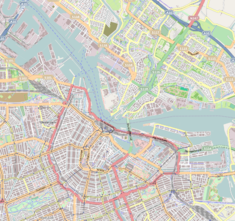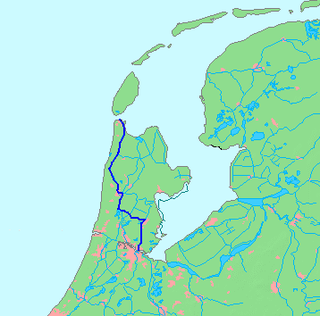
The Noordhollandsch Kanaal is a canal originally meant for ocean-going ships. It is located in North Holland, Netherlands. The canal was of great significance in Dutch history.
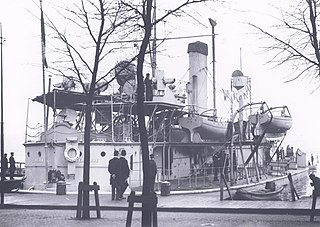
HNLMS Cerberus, was a Heiligerlee-class monitor built in Amsterdam for the Royal Netherlands Navy in the 1860s. Cerberus was a true monitor: a ship with shallow draught, only a few (heavy) guns and decent armor. These characteristics made her very suitable to operate way inland in the Dutch delta.
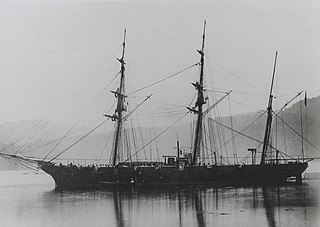
The Vesuvius class was a class of steam screw sloops of the Royal Netherlands Navy. The class comprised Vesuvius, Cornelis Dirks, Reinier Claessen, Het Loo, Reteh and Prinses Maria.

The Haarlemmermeer class was a class of nine gunvessels of the Royal Netherlands Navy. The class was a failure because of its extreme susceptibility to dry rot.

The Nederlandsche Scheepsbouw Maatschappij, was a Dutch shipbuilding company based in Amsterdam. It existed from 1894 to 1946. From c. 1908 it was the biggest Dutch shipbuilding company.

Tanjung Priok Dock of 4,000 Tons, was a floating dry dock built for Droogdok-Maatschappij Tandjong Priok in the 1890s.

Amsterdam Wooden Drydock I was the first floating dry dock of Amsterdam, and probably the first modern floating dry dock of Europe.

Amsterdam Wooden Drydock II was the second floating dry dock of Amsterdam, and was moored in the Westerdok.
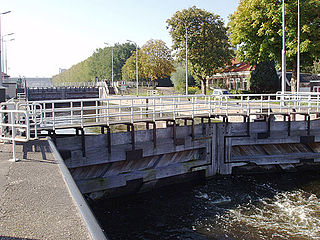
Willem I Lock is a monumental lock in Amsterdam-Noord.

Koopvaarders Lock in Den Helder, Netherlands connects the Noordhollandsch Kanaal to the Nieuwediep. There were 4 locks at Nieuwediep carrying this name.
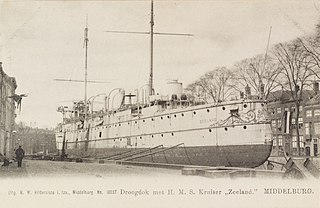
Middelburg Drydock is a former dry dock in Middelburg, Netherlands. The Dock chamber still exists.

Amsterdamsche Droogdok Maatschappij (ADM) was a Dutch company that repaired ships using dry docks in Amsterdam, Netherlands. After World War II it also built some ships.
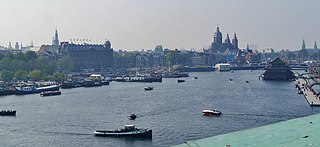
The Oosterdok is a former wet dock in Amsterdam. It was created in 1831-1832 by constructing the Oosterdoksdam and the Oosterdoksluis, forming a reliable deep port closed off from the tidal IJ.
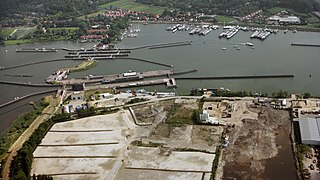
The Oranje Locks are a group of locks and other water management facilities just east of Amsterdam.

L. Smit en Zoon previously known as Fop Smit, was a Dutch shipbuilding company located in Kinderdijk. Its successor is now part of Royal IHC.

The Nederlandsche Stoomboot Maatschappij ( ), abbreviated as NSM or NSBM, was a Dutch shipping line focused on inland navigation. In the 1820s it was important for the quick introduction of steam power on the Dutch rivers and on the Rhine. NSM owned the major shipbuilding company Fijenoord.

SS De Batavier, launched in 1827 was an early steamship which served on the Rotterdam to London line of the Nederlandsche Stoomboot Maatschappij (NSM). As such she was in news quite often, but the Batavier also appeared in fiction and non-fiction. The Batavier is the location of a chapter of Thackeray's Vanity Fair.
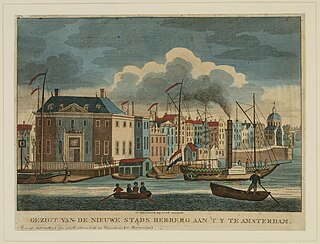
Amsterdamsche Stoomboot Maatschappij was an early Dutch steam shipping company.

The Amsterdamsche Stoom Suikerraffinaderij was a big Dutch sugar refining company. It produced white sugar by refining raw sugar from sugar cane. The company existed from 1833 to 1875 and was one of the most important industrial companies of Amsterdam.

The Halfweg sugar factory is a now defunct beet sugar factory previously known as "Suikerfabriek Holland". It closed down in 1992 and was then repurposed to become 'Sugar City', an area with offices, retail shops and an event venue. The terrain measures 11 hectares, and is hemmed in by the Haarlemmerstraatweg (N200), the Ringvaart of the Haarlemmermeer polder, and the wide part of the Ringvaart that leads to the sluices and the former Zijkanaal F. Halfweg village is on the other side of the wide part of the Ringvaart.

